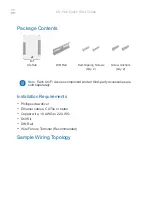
CHAPTER 19 FLASH MEMORY
Preliminary User’s Manual U19014EJ1V0UD
458
19.6 Connection of Pins on Board
To write the flash memory on-board, connectors that connect the dedicated flash memory programmer must be
provided on the target system. First provide a function that selects the normal operation mode or flash memory
programming mode on the board.
When the flash memory programming mode is set, all the pins not used for programming the flash memory are in
the same status as immediately after reset. Therefore, if the external device does not recognize the state immediately
after reset, the pins must be connected as described below.
19.6.1 FLMD0 pin
In the normal operation mode, 0 V is input to the FLMD0 pin. In the flash memory programming mode, the V
DD
write voltage is supplied to the FLMD0 pin. An FLMD0 pin connection example is shown below.
Figure 19-8. FLMD0 Pin Connection Example
V
DD
/EV
DD
V
SS
/EV
SS
RESET
TxD6
RxD6
V
DD
GND
/RESET
SI/RxD
SO/TxD
EXCLK
CLK
Dedicated flash
memory programmer
PG-FP4
(Flash Pro4)
Cxxxxxx
Bxxxxx
Axxxx
XX
X Y
YY
XXX
XX
XXXXXX
XXX
X
XXX
X Y
YYY
STATVE
FLMD0
FLMD0
PD78F0730
µ
Note
Note
19.6.2 Serial interface pins
The pins used by each serial interface are listed below.
Table 19-3. Pins Used by Each Serial Interface
Serial Interface
Pins Used
CSI10
SO10, SI10, SCK10
UART6 TxD6,
RxD6
To connect the dedicated flash memory programmer to the pins of a serial interface that is connected to another
device on the board, care must be exercised so that signals do not collide or that the other device does not
malfunction.
electronic components distributor















































